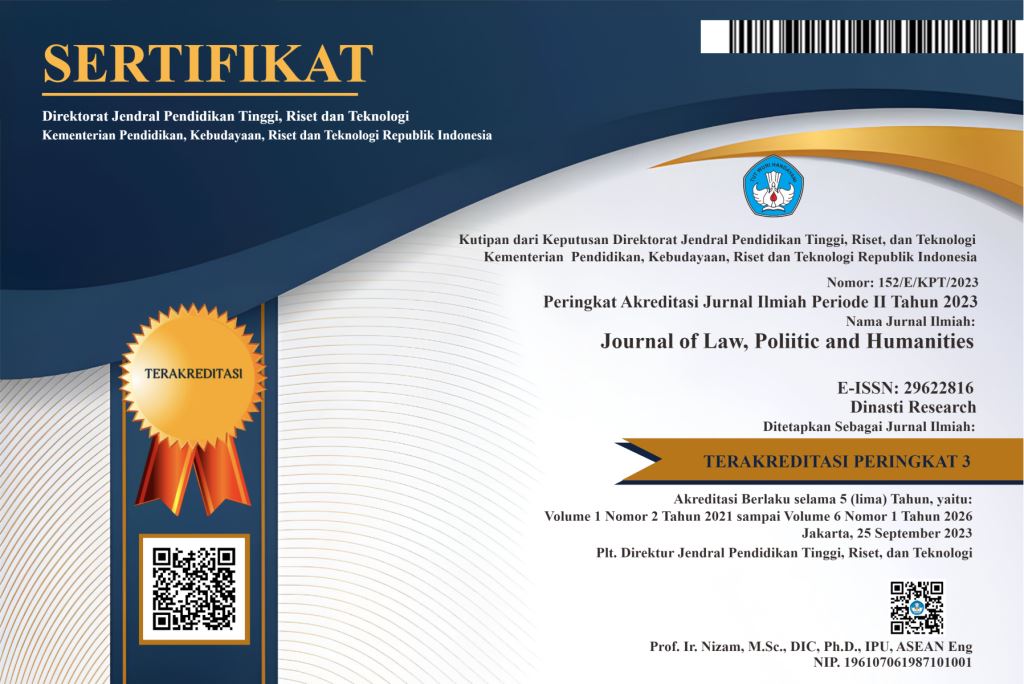Criminal Liability For The Perpetrator Of Sexual Perversion Of The Corpse
DOI:
https://doi.org/10.38035/jlph.v5i6.2346Keywords:
Necrophilia, Rape of a Corpse, Criminal LiabilityAbstract
This study discusses necrophilia as one of the deviations of sexual orientation that has not been regulated in the Criminal Code (KUHP). Although Article 271 of the Penal Code covers the regulation of corpses, excavation or demolition of tombs, retrieval, removal and transportation of bodies, and uncivilized treatment of bodies, the act of rape of bodies still does not have clear regulations. This situation creates a legal vacuum that poses new challenges, especially since necrophilia is often seen as a form of the disease. The question arises as to how legal liability can be imposed on the perpetrator in this context. The purpose of this study is to understand the regulation and form of criminal responsibility for the perpetrators of necrophilia in the context of the crime of rape of the corpse. The method used in this study is normative legal research with a legislative approach to discuss related legal issues. The results showed that criminal liability for individuals with necrophilia in the criminal act of rape of a corpse is not yet expressly provided for in the new criminal code. In the context of criminal acts, this is stipulated in Article 271 of Law Number 1 of 2023 (KUHP), while from the perspective of criminal acts rape is regulated in Article 415 of the Criminal Code. In addition, crimes against the body are also regulated in Article 415 as well as Article 269 and Article 270 of the new criminal code.
References
Mahyudin, N. (2023, Oktober). Pertanggungjawaban Pidana Masing-Masing Peserta Dalam Pembunuhan Berencana Karena Perintah Jabatan. Jurnal Lex Privatum, 7(3), 1-11.
Krueger, R. B. (2017, February). Proposals for Paraphilic Disorders in the International Classi?cation of Diseases and Related Health Problems, Eleventh Revision (ICD-11). Arch Sex Behav, 46(1), 1529–1545.
Geneva, W. H. (2004). The ICD-10 Classification of Mental and Behavioural Disorders : Clinical Descriptions and Diagnostic Guidelines. Switzerland: WHO Library Cataloguing in Publication Data.
Suganda, R. (2022, Juni). Metode Pendekatan Yuridis Dalam Memahami Sistem Penyelesaian Sengketa Ekonomi Syariah. Jurnal Ilmiah Ekonomi Islam, 8(3), 1-8.
Sayyed, H. (2024). From silence to sanction: comparative analysis of necrophilia laws in India and other countries. Law, Criminology & Criminal Justice, 10(1), 1-10.
Mwandayi, C. (2023, April). Of sin, gender equality and environmental goodness - towards curbing the effects of necrophilia. HTS Teologiese Studies/Theological Studies, 79(3), 1-8.
Poþarskis, A. (2023, Desember). Socially Dangerous Sexual Paraphilias: Description of the Problem. Proceedings of the Latvian Academy of Sciences. Section B. Natural, Exact, and Applied Sciences., 77(5/6), 217-225.
Muniati, K. D. (2023, Juni). Efektivitas Visum Et Repertum Pada Proses Penyidikan Dalam Tindak Pidana Pembunuhan Berencana. hal. 1-76.
Gaib, R. (2018, Juli). Elemen-Elemen Perbuatan Pidana Dan Kemampuan Pertanggungjawaban Pidana Menurut Kitab Undang-Undang Hukum Pidana. Lex Crimen, 7(5), 41-48.
Syahrizal, M. D. (2023, Mei). Pembaruan Hukum Terhadap Pasal 180 Kuhp Mengenai Kejahatan Terhadap Jenazah. Jurnal Kertha Semaya, 11(7), 1718-1735.
Badaru, B. (2020, September ). Kedudukan Visum Et Repertum Sebagai Alat Bukti Dalam Dakwaan Penuntut Umum Terhadap Tindak Pidana Penganiayaan Berat. Journal of Lex Generalis (JLG), 1(2), 166-182.
Awaeh, S. H. (2017, September). Penerapan Sanksi Pidana Terhadap Pelaku Kejahatan Mutilasi Menurut Pasal 340 Kitab Undang-Undang Hukum Pidana. Lex Privatum, 5(7), 5-12.
Downloads
Published
How to Cite
Issue
Section
License
Copyright (c) 2025 Nining Yurista Prawitasari, Rad Cloud Dirgantoro Kesumojati

This work is licensed under a Creative Commons Attribution 4.0 International License.
Authors who publish their manuscripts in this journal agree to the following conditions:
- The copyright on each article belongs to the author(s).
- The author acknowledges that the Journal of Law, Poliitic and Humanities (JLPH) has the right to be the first to publish with a Creative Commons Attribution 4.0 International license (Attribution 4.0 International (CC BY 4.0).
- Authors can submit articles separately, arrange for the non-exclusive distribution of manuscripts that have been published in this journal into other versions (e.g., sent to the author's institutional repository, publication into books, etc.), by acknowledging that the manuscript has been published for the first time in the Journal of Law, Poliitic and Humanities (JLPH).


























